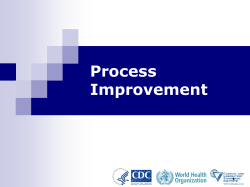
How to use the EDC packages
How to use the WCAR ECD Profiles Package How to use the ECD Country Profiles and the Regional Profile The country profiles are composed of main indicators which are useful to understand the situation of young children and families in the WCA countries. In each country profile: • BLACK INDICATORS refer to demographics (e.g. total population; total under 5 population etc.) • RED INDICATORS refer to major socio-economic barriers and constraints (e.g. child mortality, maternal mortality etc.); • BLUE INDICATORS, which are ranged in a chronological in order to illustrate the life cycle, refer to the home and family environment as well as learning opportunities available. • ORANGE, PINK and GREEN indicators are context related indicators from formal (health and education) to informal (family, social norms) systems. These indicators are interconnected and they need to be analysed with a life cycle perspective to understand risks and opportunities faced by future parents, parents and young children in each country. Here are some example to understand the linkages between some indicators and ECD: • Women aged 20-24 years old married before the age of 18. Early marriage may have a negative impact on girl’s education and domestic violence. This may also subject the girl to an early pregnancy and possible health/labour complications. And most probably poor parenting. • Birth rates among adolescents: early pregnancy expose both future mothers and children to high risks during the pregnancy period, before and after birth. Preventing early pregnancies while providing adequate age-sensitive services to pregnant adolescents and adolescent fathers could reduce serious potential consequences on the child’s physical and mental wellbeing. • Births attended by skilled health personal, as well as pre-natal and post natal care coverage may have an impact on child and maternal mortality rates. Home visiting programs and sensitization activities targeting pregnant mothers and future parents represent a good entry point for parental education provision, including messages on child development through breastfeeding, early stimulation and bonding with significant caregivers. • Female literacy rate & girl’s access to secondary education. Literate girls and women are more likely to provide adequate care to their children and promote a responsive, nurturing and safe environment. • In many countries, children 0-5 are left under the care of another child younger than 10 years old. It might be interesting to explore the broader meaning of the caregiver’s role: who -within the extended family- has a strong hierarchical decision-making power on the child, in terms of breastfeeding, nutrition, health, discipline and others. • Children aged 2-14 exposed to violent disciplinary methods and environments of domestic violence might be seriously affected, with lifelong consequences -in terms of brain development- because of the constant exposure to stress. Promoting positive parenting and providing adequate support to vulnerable families could greatly reduce violence against children. • Gross enrolment ratio in pre-primary education. Children with quality early learning opportunities may have more chances to succeed in their educational pathways. Impacting not only the child but also the education system by facilitating right-age admission reducing repeater’s rates and improving completion rates and overall learning. Various entry points for ECD can be found, also leaving room for innovation and improvements to existing policies and programmes. How to use the Regional Institutional Mapping Early Childhood Development: ministries in charge, policies and the regional prototype This regional map provides us a snapshot of ECD institutional environments and the advancements of the regional prototype in West and Central Africa. It contains various types of information: 1. Ministry(s) in charge of ECD in each country: for most countries ECD depends of various Ministries. In some countries the Ministry of Education responds for the preschool sector and Ministries such as Social Welfare or Health, are eventually responsible of day cares and other structures for the 0-3 age group. There are cases on which the Ministry of Education is accountable for ECD in its integrity; 2. ECD National Policy: Almost all countries have an ECD National Policy, for some countries it is still on draft and not yet adopted. Other countries, such as Gabon and Ivory Coast don’t count with a national ECD policy, but it doesn’t mean that they don’t have any ECD activities. The existence of a national policy could indeed promote ECD outcomes, but it has to be structured around multiple actors held accountable, concrete objectives based on evidence generated at the country level, a monitoring and evaluation plan and budgets. 3. The ECD Regional Prototype: as WCARO supported already ten countries since 2012 with the ECD regional prototype: i) early learning assessment, ii) parental behavior survey and iii) costing model, these three tools have evolved thanks to its implementation in different countries. The main purpose of the prototype is evidence generation on quality of existing preschool services, interactions within the family and costing of ECD interventions. The prototype has revealed promising results and it has the potential to provide clear action points. But it remains a work in progress. Note for the user o Not all indicators are represented. Aspects such as health and nutrition status of the mother, access to water and sanitation, the number of children sleeping under mosquito nets -which are highly relevant- couldn’t fit. o Data constraints: this has been a challenging point, since the country profiles were different from one country to another depending on the availability of the data. This is why we decided to keep the N/A indicators to encourage filling the gap, with similar indicators related to the home and family environments particularly.
© Copyright 2025















